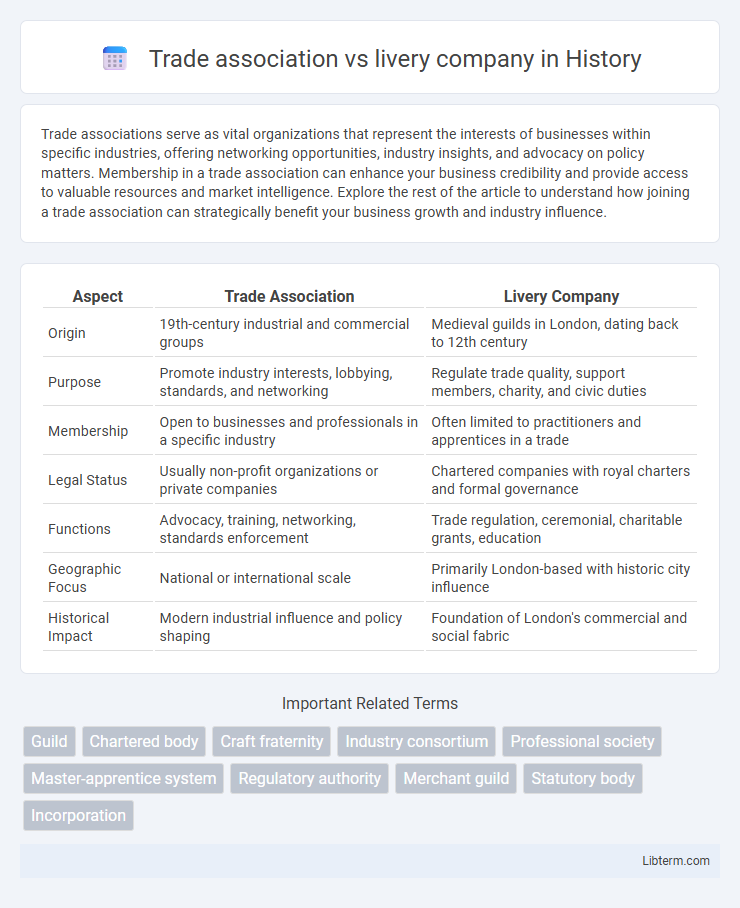Trade associations serve as vital organizations that represent the interests of businesses within specific industries, offering networking opportunities, industry insights, and advocacy on policy matters. Membership in a trade association can enhance your business credibility and provide access to valuable resources and market intelligence. Explore the rest of the article to understand how joining a trade association can strategically benefit your business growth and industry influence.
Table of Comparison
| Aspect | Trade Association | Livery Company |
|---|---|---|
| Origin | 19th-century industrial and commercial groups | Medieval guilds in London, dating back to 12th century |
| Purpose | Promote industry interests, lobbying, standards, and networking | Regulate trade quality, support members, charity, and civic duties |
| Membership | Open to businesses and professionals in a specific industry | Often limited to practitioners and apprentices in a trade |
| Legal Status | Usually non-profit organizations or private companies | Chartered companies with royal charters and formal governance |
| Functions | Advocacy, training, networking, standards enforcement | Trade regulation, ceremonial, charitable grants, education |
| Geographic Focus | National or international scale | Primarily London-based with historic city influence |
| Historical Impact | Modern industrial influence and policy shaping | Foundation of London's commercial and social fabric |
Introduction to Trade Associations and Livery Companies
Trade associations are member-based organizations representing businesses within a specific industry, aimed at promoting standards, lobbying, and networking opportunities. Livery companies, originating from medieval guilds, function both as trade associations and charitable institutions, maintaining centuries-old traditions within the City of London. Both entities play crucial roles in supporting businesses, but livery companies also emphasize heritage, ceremonial roles, and philanthropy.
Historical Origins and Evolution
Trade associations originated in the late 19th century as modern organizations representing specific industries to advocate for business interests and standardize practices. Livery companies date back to medieval London, evolving from medieval guilds that regulated trade, ensured quality, and controlled apprenticeships within particular crafts. Over time, trade associations have focused on contemporary commercial advocacy while livery companies maintain ceremonial and charitable roles rooted in centuries-old traditions.
Core Purposes and Objectives
Trade associations primarily focus on representing and supporting the interests of businesses within a specific industry by advocating for favorable regulations, providing networking opportunities, and promoting industry standards. Livery companies, originating from medieval guilds, emphasize the preservation of trade traditions, education, and charitable activities within their respective crafts or professions. Both entities aim to enhance professional integrity and influence industry development, but trade associations center on current commercial interests while livery companies prioritize heritage and community engagement.
Membership Structure and Criteria
Trade associations typically have a membership structure based on businesses and professionals within a specific industry, requiring criteria such as active participation in the trade and payment of membership dues. Livery companies in London possess a unique membership system rooted in historical guild traditions, with criteria often including apprenticeship completion, sponsorship by existing members, and formal ceremonies for admission. While trade associations prioritize collective industry representation and networking, livery companies emphasize heritage, ceremonial roles, and charitable activities alongside membership qualifications.
Governance and Organizational Framework
Trade associations operate under a membership-driven governance structure featuring elected boards and committees that represent diverse industry stakeholders, ensuring democratic decision-making and advocacy. Livery companies maintain a traditional hierarchical framework guided by a Master, Wardens, and a Court of Assistants, emphasizing ceremonial roles alongside professional oversight. The organizational framework of trade associations prioritizes flexibility and member services, while livery companies focus on historical customs, charitable activities, and maintaining industry standards through established rituals.
Key Functions and Activities
Trade associations primarily focus on representing the interests of businesses within a specific industry, providing advocacy, networking opportunities, and industry standards development. Livery companies, rooted in historical guild traditions, emphasize charitable activities, maintaining trade standards, and supporting education and apprenticeships within their respective crafts. Both entities engage in promoting professional excellence, but trade associations concentrate on contemporary industry challenges while livery companies preserve heritage and community engagement.
Influence on Industry Standards and Policy
Trade associations play a crucial role in shaping industry standards and influencing policy by actively lobbying government bodies, developing best practice guidelines, and organizing industry-wide collaborations. Livery companies, rooted in historical guild traditions, contribute to setting professional standards and ethical codes within specific trades, often leveraging their ceremonial and charitable influence to uphold industry reputation and skills development. Both entities help shape regulatory frameworks, but trade associations typically exert more direct policy influence through modern advocacy and stakeholder engagement.
Role in Education and Professional Development
Trade associations provide specialized training programs, certifications, and workshops designed to enhance industry-specific skills and knowledge, supporting continuous professional development for members. Livery companies historically sponsor apprenticeships and scholarships, fostering traditional craft skills and promoting educational initiatives within their respective trades. Both entities contribute to workforce development but differ in scope, with trade associations emphasizing contemporary industry standards and livery companies focusing on heritage and craft education.
Modern Relevance and Adaptation
Trade associations drive industry innovation by advocating regulatory reforms and providing networking platforms for contemporary businesses, enhancing competitiveness in global markets. Livery companies, while rooted in historical traditions, have adapted by supporting education, charitable activities, and maintaining industry standards relevant to current professional practices. Both entities contribute uniquely to modern trade ecosystems, with trade associations emphasizing dynamic sector growth and livery companies preserving heritage while fostering professional development.
Comparison: Trade Association vs Livery Company
Trade associations primarily serve as advocacy and networking organizations representing specific industries or business sectors, while livery companies are historic guilds in the City of London with ceremonial roles and charitable activities. Trade associations focus on member services such as lobbying, market research, and professional development, whereas livery companies emphasize tradition, regulation of trades, and community engagement. The governance structures also differ, with trade associations typically governed by industry-elected boards, and livery companies managed by an elected Master and Court of Assistants.
Trade association Infographic

 libterm.com
libterm.com